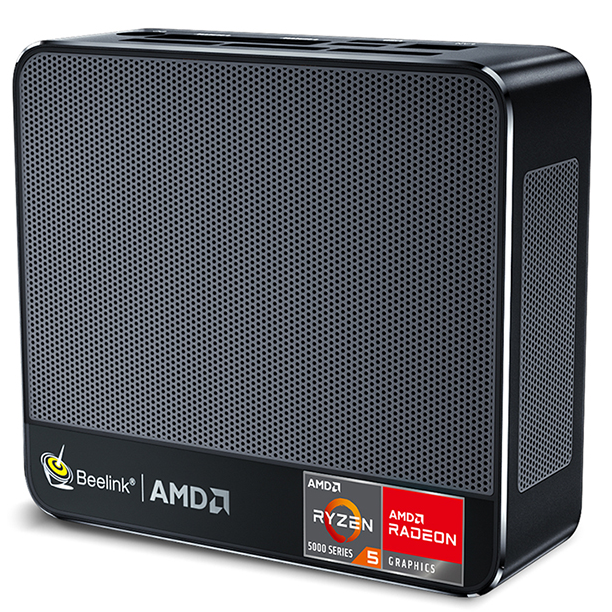
About a month ago I bought a Beelink SER5 Pro Mini PC and have been using it as a desktop and test machine. I thought I’d give a quick review in case anybody else is looking at one of these for their own use.
The SER5 was a bit shy of $400 with an AMD Ryzen 5 5600H, 32GB of RAM, and a 500GB NVMe drive. Its footprint is about 4.5 inches (almost) square, and not quite 2 inches tall. That’s 126mm wide, 113mm long, 42mm tall if you prefer metric. It’s got 3 USB 3.2 Gen 2 ports, 1 USB 2.0 port, a 1GB Ethernet port, 2 HDMI ports, and a single USB-C port.
Despite its tiny footprint, it’s got room for a 2.5" SSD in addition to the included NVMe drive. I also wanted to upgrade it to 64GB of RAM, so I popped it open shortly after it arrived to plop in an SSD and swap out the RAM.
Adding the SSD is super-easy. Unscrew the bottom plate, slide it in, done. Swapping out the RAM is more involved, you need to remove quite a few more parts to get to the DIMM slots. It’s not terrible, but took me several minutes to disassemble and re-assemble the SER5.
It came with Windows 11 Pro pre-installed, if you like that sort of thing. I don’t, so as soon as I’d finished minor surgery to upgrade it, I installed Red Hat Enterprise Linux (RHEL) 8.7 on it. (I’m using the free Developer Subscription, so it’s actual RHEL and not one of the RHEL clones.)
Installing Linux was easy, no complaints with the EFI firmware interface or whatever that comes with the system.
Desktop use and hardware support
The Beelink SER5 makes a really nice little Linux boxen. All of the components seem well-supported, though Red Hat Insights gave me a bit of a warning that the CPU or motherboard wasn’t technically supported. (I should’ve saved the warning.) It works fine, I’m assuming I’m just seeing that because this isn’t certified hardware. Not a shock.
Certified or not, everything seems to work just fine. I’ve tried it with several combos of monitors, keyboards, input devices, and USB-C hubs. No problems at all. I drove two widescreen HDMI monitors via the HDMI ports, and I’ve used it with a Samsung Odyssey CRG9 49" monitor (5120x1440) via a USB-C to DisplayPort adapter. The Samsung came up initially with the wrong resolution, but a quick dip into the settings and all was well.
Presumably it could power 3 displays, but I haven’t had the need to experiment with that.
The RHEL 8.7 GNOME desktop is snappy on this little beastie, and it makes a great little test machine. I haven’t tried any games on it, so I have no idea how it’d do with any reasonably modern games – but I already have a gaming laptop anyway.
Also worth noting: It’s super-quiet. There’s a whisper of fan noise when I power it on, and that’s about it.
Beelink SER5 Cons
It’s inexpensive and performant, what’s not to like? To be honest I have very few quibbles with the machine. If I were designing it from scratch there are a few things I’d like to see done differently.
- The USB-C port would be better located in the rear of the machine than the front.
- More USB-C ports.
- It’d be great if it had a Thunderbolt port. Not sure if that’s likely on a mini AMD motherboard, though.
- Barebones option: I’d love to have been able to buy this without a Windows tax and with no RAM. Now I’ve got 32GB of RAM gathering dust and don’t intend to use Windows on it.
And…that’s really it. For the price, it’s a fantastic little PC. It’d make a great little Plex server or home entertainment server if you needed that kind of thing.
Assuming it doesn’t die in the next couple of years, I’d happily buy a Beelink Mini PC again in the future when I need to update my desktop.
